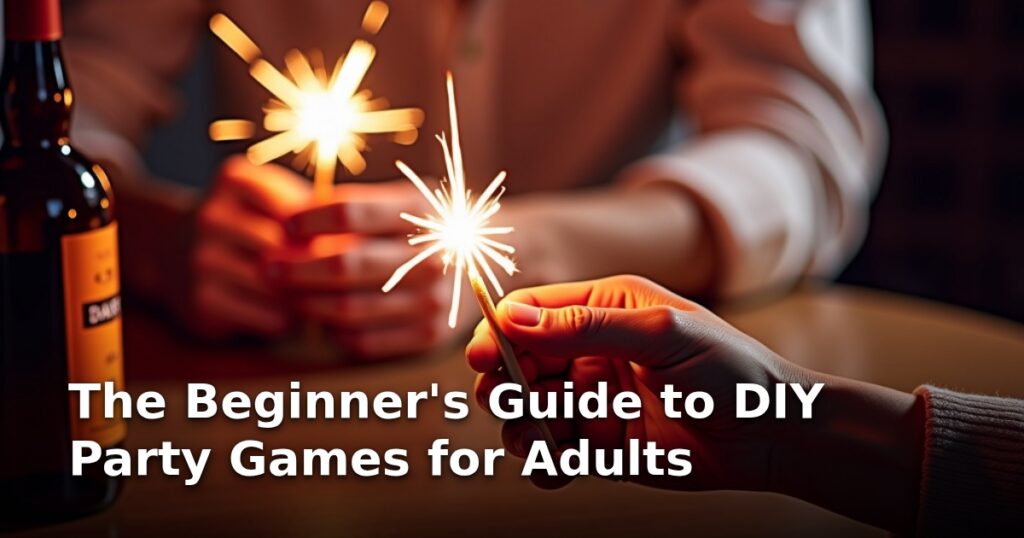The Beginner's Guide to DIY Party Games for Adults
So, you’ve decided to throw a party. Maybe it’s a milestone birthday, a casual get-together, or perhaps you’re planning a themed evening like an elegant dinner party theme or a laid-back gathering centered around low-cost birthday themes. Whatever the occasion, one thing often stumps beginners: keeping the energy up! That’s where DIY party games for adults come in. Forget spending a fortune on elaborate entertainment; we’re diving into fun, homemade activities that will make your event memorable without breaking the bank.
This guide is designed for the absolute beginner—the person who thinks "DIY" means "too complicated." Trust me, if you can staple two pieces of paper together, you can master these games!
What Exactly Are DIY Party Games?
Simply put, DIY party games are activities you create or assemble yourself using common household items or inexpensive craft supplies. Think less "professionally manufactured board game" and more "clever activity using index cards, pens, and maybe some string."
These games are the backbone of great party ideas. They allow you to customize the fun entirely to your guest list, whether you’re hosting a group of close friends or planning retirement party themes for men that require a bit more structured entertainment.
Why DIY Games Are Your Party Superpower
Why bother making your own games when you can just buy something pre-made? There are several huge benefits, especially for the budget-conscious host:
- Cost-Effective: This is the big one. DIY games are inherently cheap. They fit perfectly alongside using cheap party decorations and following a free party planning checklist.
- Customization: You can tailor the humor, complexity, and theme instantly. Planning teenager party themes at home? Make the game about inside jokes. Hosting a sophisticated cocktail hour? Create a trivia game to match your themed cocktail party menus.
- Engagement: Homemade games often require more interaction than passive entertainment, making your guests feel more involved.
Basic Terminology and Concepts for New Hosts
Before we get into the games, let's quickly define a few terms you might hear when planning:

- Icebreaker: A short, low-stakes game played at the beginning of a party to help guests who don't know each other relax and start talking.
- Main Event Game: The central, longer activity of the evening. This could be anything from charades to a complex scavenger hunt.
- Props: Any physical item needed for the game (e.g., a bowl, slips of paper, markers). Keep your props simple, especially if you’re working with a small space party layout ideas.
- Theming: Matching the game's aesthetic or content to your overall party theme. This is crucial for events like an interactive murder mystery party kits experience, even if you're just making a simplified version yourself.
Getting Started: Your First Three DIY Game Steps
Don't feel overwhelmed by the prospect of hosting. Follow these simple steps to launch your DIY game adventure.
Step 1: Know Your Audience
The most important rule in party planning, whether you’re aiming for low-cost birthday themes or a formal gathering, is knowing who is coming.
- Are they competitive? If yes, lean toward timed challenges.
- Are they shy? Start with simple, small-team icebreakers.
- Are you hosting remotely? You’ll need adaptable virtual party game ideas.
Step 2: Choose Your Format
Most DIY games fall into one of three easy formats:
- Trivia/Knowledge: Easy to write on index cards. Theme it around history, pop culture, or even obscure facts about the guest of honor.
- Performance/Acting: Games like Pictionary or Charades. All you need is paper and pens.
- Physical Challenge (Low-Impact): Quick challenges using household items—think stacking cups or moving objects using only a straw.
Step 3: Assemble Your "Game Kit"

Create a small box or tote dedicated just to your games. This makes logistics easy, especially if you are working with a last minute party planning guide. Your kit should contain essentials like:
- Pens/Markers
- Index cards or sticky notes
- A timer (your phone works great!)
- A bowl or hat for drawing prompts
Three Super Simple DIY Games for Any Adult Gathering
Here are three tried-and-true games requiring almost zero specialized skill:
1. Two Truths and a Lie (The Classic Icebreaker)
- What it is: Each person shares three "facts" about themselves—two true, one false. The group votes on which one they think is the lie.
- DIY Element: None! Just verbal participation.
- Beginner Tip: Encourage guests to write their three statements down first. This gives shy guests time to think and ensures everyone participates equally.
2. Celebrity/Character Name Game (The Head Scramble)
- What it is: Write the names of famous people, characters, or inside jokes on sticky notes. Stick one note to each guest’s forehead without them seeing it. They must ask yes-or-no questions to figure out who they are.
- DIY Element: Sticky notes and pens.
- Beginner Tip: Tailor the names! For a retirement party theme for men, use famous figures from their career era. For a general party, use current celebrities.
3. Collaborative Storytelling (The Narrative Chain)
- What it is: The first person starts a story with one sentence. The next person adds a sentence, and so on, until the story reaches a ridiculous conclusion.
- DIY Element: Zero required, but you can pass a physical object (like a silly hat) that signals whose turn it is to keep the flow moving.

Common Beginner Mistakes to Avoid
Even with simple games, beginners sometimes trip up. Here are the pitfalls to sidestep:
- Over-Complicating Rules: If you have to read a paragraph of instructions, the game is too complex for a casual party. Keep rules under three sentences.
- Forcing Participation: Never pressure a guest to play. Always have an alternative activity ready, like offering them a role in managing the music or drinks.
- Ignoring the Theme: Even if you are using cheap party decorations, a game that completely clashes with the vibe (e.g., a loud, messy game at an elegant dinner party theme) can kill the mood.
Next Steps for Continued DIY Party Mastery
Once you’ve mastered the basics, you’re ready to expand your repertoire. Your next logical steps include:
- Experimenting with Virtual Adaptation: Look up how to adapt your favorite in-person games for platforms like Zoom. Many traditional games work wonderfully as virtual party game ideas with a little tweaking.
- Integrating Props: Start thinking about simple challenges that require minor assembly, like creating a makeshift "laser maze" using yarn in a hallway, which is perfect for smaller venues or small space party layout ideas.
- Theme Integration: For your next event, actively seek out free printable templates online that match your chosen theme—this is the easiest way to elevate any DIY effort.
Conclusion: You Are Now a Party Game Guru!
See? Planning fun doesn’t require a massive budget or an event planning degree. By embracing DIY party games for adults, you gain control over the atmosphere, save money, and inject genuine, personalized fun into your gathering.
Whether you’re ticking items off your free party planning checklist or scrambling to organize a great time using your last minute party planning guide, remember that the best entertainment comes from connection, not cost. Go forth, use those index cards wisely, and host a fantastic party!



